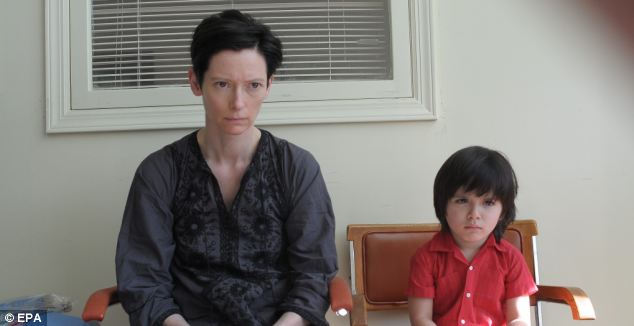
Scientists have found that certain areas of a psychopath's brain showed a reduced activity in response to images of others in pain.
The regions affected are those known to play a role in empathy, the ability to relate to other people's feelings.
Scientists say the patterns could act as a marker to single out children at a risk of becoming adult psychopaths.
A total of 55 boys aged 10 to 16 were assessed in the study.
Of these, 37 met the criteria for children with 'conduct problems' (CP) according to questionnaire answers provided by parents and teachers.
CP children display a plethora of antisocial traits including aggression and dishonesty.
Like the central character in Lionel Shriver's novel We Need to Talk About Kevin, they can be callous and cruel.
Youngsters with conduct problems are not likely to follow in Kevin's footsteps and commit a school massacre, but the research findings suggest at least some could grow up to be psychopaths.
Comment: Psychopathy is genetic, therefore one cannot "grow up to be a psychopath". This point should be emphasized, especially when it comes to children' diagnosis and misguided attempts to "cure" psychopathy. It's important to note, that psychopathy can be both categorical and dimensional. That is, there are types and gradations of psychopaths. Martha Stout makes this pretty clear in The Sociopath Next Door. Some of them can be very covert, some can be "raging" mad dog types, others can be pitiful/poor me game players, etc.
Or, there can be individuals who are not psychopaths who react psychopathically when triggered because that is the kind of programming they have from their upbringing and exposure to pathological behavior. In that case, it is not really a psychopath, but rather a sociopath/ a "situational psychopath" who can also be described as a secondary psychopath.
Read the following books to learn more on the topic:
Political Ponerology - A Science on the Nature of Evil Adjusted for Political Purposes by Andrzej M. Lobaczewski.
The Mask of Sanity by Hervey Cleckley, M.D.
Snakes in Suits: When Psychopaths Go to Work by Paul Babiak, Ph.D., and psychopathy expert Dr Robert D. Hare.
'Our findings indicate that children with conduct problems have an atypical brain response to seeing other people in pain,' psychologist Professor Essi Viding from University College London said.
'It is important to view these findings as an indicator of early vulnerability, rather than biological destiny.
'We know that children can be very responsive to interventions, and the challenge is to make those interventions even better, so that we can really help the children, their families, and their wider social environment.'
About five per cent of children qualify for a diagnosis of CP, but little is known about the condition's underlying cause.
Participants in the study underwent functional magnetic resonance imaging (fMRI) scans while being shown images of other people's hands and feet in painful and non-painful situations.
A distinct difference was seen in the brain responses of children with and without CP.
In children with conduct problems, brain activity in three key regions was reduced when looking at the pictures. They were the bilateral anterior insula, the anterior cingulate cortex, and the inferior frontal gyrus.
All are regions associated in previous studies with feelings of empathy for others in pain.
The scientists wrote in the journal Current Biology: 'We show that callous traits in particular may underlie atypical neural responses to others' pain in CP, which may represent an early neurobiological marker for later psychopathy.
'It remains an empirical question whether empathic responding can be normalised in children with CP.'
Not all children with conduct problems displayed a vulnerability to psychopathy, the researchers stressed.
'This raises the possibility of tailoring existing interventions to suit the specific profile of atypical processing that characterises a child with conduct problems,' Prof Viding said.



Yes, and that also means that it could very well ALSO be epigenetic.
The old idea of genetics was much like instructions written in stone, being read out as genetic flaws in a statistical sense.
The new approach is more of our DNA's methylation ( epigenetic, actuating or turning off DNA segments ) being like an instrument's "keyboard" -- where the "fingers" of environmental toxicity and diet / lifestyle / childhood trauma -- "play" in a sense or exercise various aspects as increased susceptibility.
Perhaps many of the scientific community are as yet mistaken ( about the roots of psychopathy ), as this is a very new area of research, particularly with the huge piles of evidence of A.dverse C.hildhood E.xperiences ( ACE studies ) being increasingly seen as the progenitors of many forms of adult disease ( lifelong and earlier ).
See the book "Scared Sick: The Role of Childhood Trauma in Adult Disease,"
See ( [Link] )
Wouldn't all humans live and sleep a lot better, if we could possibly discover the ways that psychopathy is activated, and then ALSO the possible discovery of the reverse ?
Many illnesses are being treated successfully my addressing how epigenetic stressors were turned on, and then by changing lifestyle behaviors to learn to turn them off ( e.g. women's health issues, timing the use of certain foods. occurring in both the day and month ).
Namaste